Potassium
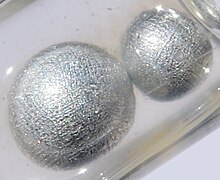 Potassium pearls (in paraffin oil, ~5 mm each) | ||||||||||||||||||||||||||||||
| Potassium | ||||||||||||||||||||||||||||||
|---|---|---|---|---|---|---|---|---|---|---|---|---|---|---|---|---|---|---|---|---|---|---|---|---|---|---|---|---|---|---|
| Appearance | silvery white, faint bluish-purple hue when exposed to air | |||||||||||||||||||||||||||||
| Standard atomic weight Ar°(K) | ||||||||||||||||||||||||||||||
| Potassium in the periodic table | ||||||||||||||||||||||||||||||
| ||||||||||||||||||||||||||||||
New Latin kalium | ||||||||||||||||||||||||||||||
| Isotopes of potassium | ||||||||||||||||||||||||||||||
| ||||||||||||||||||||||||||||||
Potassium is a
Potassium is chemically very similar to
Potassium ions are vital for the functioning of all living cells. The transfer of potassium ions across nerve cell membranes is necessary for normal nerve transmission; potassium deficiency and excess can each result in numerous signs and symptoms, including an abnormal heart rhythm and various
Most industrial applications of potassium exploit the high solubility of its compounds in water, such as saltwater soap. Heavy crop production rapidly depletes the soil of potassium, and this can be remedied with agricultural fertilizers containing potassium, accounting for 95% of global potassium chemical production.[13]
Etymology
The English name for the element potassium comes from the word potash,[14] which refers to an early method of extracting various potassium salts: placing in a pot the ash of burnt wood or tree leaves, adding water, heating, and evaporating the solution. When Humphry Davy first isolated the pure element using electrolysis in 1807, he named it potassium, which he derived from the word potash.
The symbol K stems from kali, itself from the root word
The English and French-speaking countries adopted the name Potassium, which was favored by Davy and French chemists Joseph Louis Gay-Lussac and Louis Jacques Thénard, whereas the other Germanic countries adopted Gilbert and Klaproth's name Kalium.[18] The "Gold Book" of the International Union of Pure and Applied Chemistry has designated the official chemical symbol as K.[19]
Properties
Physical
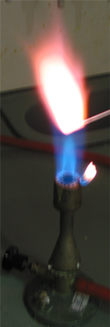
Potassium is the second least dense metal after lithium. It is a soft solid with a low melting point, and can be easily cut with a knife. Potassium is silvery in appearance, but it begins to tarnish toward gray immediately on exposure to air.[20] In a flame test, potassium and its compounds emit a lilac color with a peak emission wavelength of 766.5 nanometers.[21]
Neutral potassium atoms have 19 electrons, one more than the configuration of the noble gas argon. Because of its low first ionization energy of 418.8 kJ/mol, the potassium atom is much more likely to lose the last electron and acquire a positive charge, although negatively charged alkalide K− ions are not impossible.[22] In contrast, the second ionization energy is very high (3052 kJ/mol).
Chemical
Potassium reacts with oxygen, water, and carbon dioxide components in air. With oxygen it forms
Compounds

Four oxides of potassium are well studied: potassium oxide (K2O), potassium peroxide (K2O2), potassium superoxide (KO2)[24] and potassium ozonide (KO3). The binary potassium-oxygen compounds react with water forming KOH.
KOH is a
In general, potassium compounds are ionic and, owing to the high hydration energy of the K+ ion, have excellent water solubility. The main species in water solution are the aquo complexes [K(H2O)n]+ where n = 6 and 7.[27]
Potassium heptafluorotantalate (K2[TaF7]) is an intermediate in the purification of tantalum from the otherwise persistent contaminant of niobium.[28]
Isotopes
There are 25 known
on Earth.40
K occurs in natural potassium (and thus in some commercial salt substitutes) in sufficient quantity that large bags of those substitutes can be used as a radioactive source for classroom demonstrations. 40
K is the radioisotope with the largest abundance in the human body. In healthy animals and people, 40
K represents the largest source of radioactivity, greater even than 14
C. In a human body of 70 kg, about 4,400 nuclei of 40
K decay per second.[32] The activity of natural potassium is 31 Bq/g.[33]
History
Potash
Potash is primarily a mixture of potassium salts because plants have little or no sodium content, and the rest of a plant's major mineral content consists of calcium salts of relatively low solubility in water. While potash has been used since ancient times, its composition was not understood.
Metal

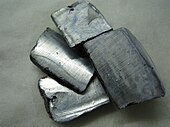
Potassium metal was first isolated in 1807 by Humphry Davy, who derived it by electrolysis of molten
Because of the sensitivity of potassium to water and air,
- MgCl2 + 2 K → Mg + 2 KCl
Occurrence

Potassium is formed in
Potassium is the 20th most abundant element in the solar system and the 17th most abundant element by weight in the Earth. It makes up about 2.6% of the weight of the Earth's crust and is the seventh most abundant element in the crust.[52] The potassium concentration in seawater is 0.39 g/L[9] (0.039 wt/v%), about one twenty-seventh the concentration of sodium.[53][54]
Geology
Elemental potassium does not occur in nature because of its high reactivity. It reacts violently with water[47] and also reacts with oxygen. Orthoclase (potassium feldspar) is a common rock-forming mineral. Granite for example contains 5% potassium, which is well above the average in the Earth's crust. Sylvite (KCl), carnallite (KCl·MgCl2·6H2O), kainite (MgSO4·KCl·3H2O) and langbeinite (MgSO4·K2SO4) are the minerals found in large evaporite deposits worldwide. The deposits often show layers starting with the least soluble at the bottom and the most soluble on top.[54] Deposits of niter (potassium nitrate) are formed by decomposition of organic material in contact with atmosphere, mostly in caves; because of the good water solubility of niter the formation of larger deposits requires special environmental conditions.[55]
Commercial production
Mining
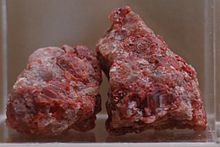
Potassium salts such as
Chemical extraction
Several methods are used to separate potassium salts from sodium and magnesium compounds. The most-used method is fractional precipitation using the solubility differences of the salts. Electrostatic separation of the ground salt mixture is also used in some mines. The resulting sodium and magnesium waste is either stored underground or piled up in
Pure potassium metal can be isolated by electrolysis of its hydroxide in a process that has changed little since it was first used by Humphry Davy in 1807. Although the electrolysis process was developed and used in industrial scale in the 1920s, the thermal method by reacting sodium with potassium chloride in a chemical equilibrium reaction became the dominant method in the 1950s.
- Na + KCl → NaCl + K
The production of
- 2 KF + CaC2 → 2 K + CaF2 + 2 C
Cation identification
Potassium is now quantified by ionization techniques, but at one time it was quantitated by gravimetric analysis.
Reagents used to precipitate potassium salts include
- 3 K+ + Na3[Co(NO2)6] → K3[Co(NO2)6] + 3 Na+
The potassium cobaltinitrite is obtained as a yellow solid.
Commercial uses
Fertilizer
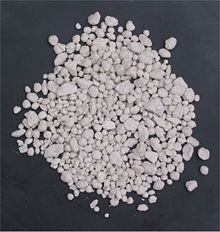
Potassium ions are an essential component of
Medical use
Potassium citrate
Potassium chloride
Potassium, in the form of potassium chloride is used as a medication to treat and prevent
Food additives
Potassium sodium tartrate (KNaC4H4O6,
Industrial
Major potassium chemicals are potassium hydroxide, potassium carbonate, potassium sulfate, and potassium chloride. Megatons of these compounds are produced annually.[71]
KOH is a strong base, which is used in industry to neutralize strong and weak
While
Niche uses
There are thousands of uses of various potassium compounds. One example is potassium superoxide, KO2, an orange solid that acts as a portable source of oxygen and a carbon dioxide absorber. It is widely used in respiration systems in mines, submarines and spacecraft as it takes less volume than the gaseous oxygen.[77][78]
- 4 KO2 + 2 CO2 → 2 K2CO3 + 3 O2
Another example is
The stable isotopes of potassium can be laser cooled and used to probe fundamental and technological problems in quantum physics. The two bosonic isotopes possess convenient Feshbach resonances to enable studies requiring tunable interactions, while 40
K is one of only two stable fermions amongst the alkali metals.[80]
Laboratory uses
An
Metallic potassium is used in several types of magnetometers.[82]
Biological role
Potassium is the eighth or ninth most common element by mass (0.2%) in the human body, so that a 60 kg adult contains a total of about 120 g of potassium.
Biochemical function
Potassium levels influence multiple physiological processes, including[86][87][88]
- resting cellular-membrane potential and the propagation of action potentials in neuronal, muscular, and cardiac tissue. Due to the electrostatic and chemical properties, K+ ions are larger than Na+ ions, and ion channels and pumps in cell membranes can differentiate between the two ions, actively pumping or passively passing one of the two ions while blocking the other.[89]
- hormone secretion and action
- vascular tone
- systemic blood pressure control
- gastrointestinal motility
- acid–base homeostasis
- glucose and insulin metabolism
- mineralocorticoid action
- renal concentrating ability
- fluid and electrolyte balance
- local cortical monoaminergic norepinephrine, serotonin, and dopamine levels, and through them, sleep/wake balance, and spontaneous activity.[90]
Homeostasis
Potassium homeostasis denotes the maintenance of the total body potassium content, plasma potassium level, and the ratio of the intracellular to extracellular potassium concentrations within narrow limits, in the face of pulsatile intake (meals), obligatory renal excretion, and shifts between intracellular and extracellular compartments.
Plasma levels
Plasma potassium is normally kept at 3.5 to 5.5 millimoles (mmol) [or milliequivalents (mEq)] per liter by multiple mechanisms.[91] Levels outside this range are associated with an increasing rate of death from multiple causes,[92] and some cardiac, kidney,[93] and lung diseases progress more rapidly if serum potassium levels are not maintained within the normal range.
An average meal of 40–50 mmol presents the body with more potassium than is present in all plasma (20–25 mmol). This surge causes the plasma potassium to rise up to 10% before clearance by renal and extrarenal mechanisms.[94]
Control mechanisms
Potassium content in the plasma is tightly controlled by four basic mechanisms, which have various names and classifications. These are:
- a reactive negative-feedback system,
- a reactive feed-forward system,
- a predictive or circadiansystem, and
- an internal or cell membrane transport system.
Collectively, the first three are sometimes termed the "external potassium homeostasis system";[97] and the first two, the "reactive potassium homeostasis system".
- The reactive negative-feedback system refers to the system that induces renal secretion of potassium in response to a rise in the plasma potassium (potassium ingestion, shift out of cells, or intravenous infusion.)
- The reactive feed-forward system refers to an incompletely understood system that induces renal potassium secretion in response to potassium ingestion prior to any rise in the plasma potassium. This is probably initiated by gut cell potassium receptors that detect ingested potassium and trigger vagal afferentsignals to the pituitary gland.
- The predictive or circadian system increases renal secretion of potassium during mealtime hours (e.g. daytime for humans, nighttime for rodents) independent of the presence, amount, or absence of potassium ingestion. It is mediated by a sodium-potassium pump is an example of primary active transport. The two carrier proteins embedded in the cell membrane on the left are using ATPto move sodium out of the cell against the concentration gradient; The two proteins on the right are using secondary active transport to move potassium into the cell. This process results in reconstitution of ATP.
- The ion transport system moves potassium across the cell membrane using two mechanisms. One is active and pumps sodium out of, and potassium into, the cell. The other is passive and allows potassium to leak out of the cell. Potassium and sodium cations influence fluid distribution between intracellular and extracellular compartments by prokaryotic species.[99]
Renal filtration, reabsorption, and excretion
Renal handling of potassium is closely connected to sodium handling. Potassium is the major cation (positive ion) inside animal cells (150 mmol/L, 4.8 g/L), while sodium is the major cation of
Sodium is reabsorbed to maintain extracellular volume, osmotic pressure, and serum sodium concentration within narrow limits. Potassium is reabsorbed to maintain serum potassium concentration within narrow limits.
With no potassium intake, it is excreted at about 200 mg per day until, in about a week, potassium in the serum declines to a mildly deficient level of 3.0–3.5 mmol/L.[106] If potassium is still withheld, the concentration continues to fall until a severe deficiency causes eventual death.[107]
The potassium moves passively through pores in the cell membrane. When ions move through ion transporters (pumps) there is a gate in the pumps on both sides of the cell membrane and only one gate can be open at once. As a result, approximately 100 ions are forced through per second. Ion channels have only one gate, and there only one kind of ion can stream through, at 10 million to 100 million ions per second.[108] Calcium is required to open the pores,[109] although calcium may work in reverse by blocking at least one of the pores.[110] Carbonyl groups inside the pore on the amino acids mimic the water hydration that takes place in water solution[111] by the nature of the electrostatic charges on four carbonyl groups inside the pore.[112]
Nutrition
Dietary recommendations
The U.S.
For both males and females under 9 years of age, the AIs for potassium are: 400 mg of potassium for 0 to 6-month-old infants, 860 mg of potassium for 7 to 12-month-old infants, 2,000 mg of potassium for 1 to 3-year-old children, and 2,300 mg of potassium for 4 to 8-year-old children.
For males 9 years of age and older, the AIs for potassium are: 2,500 mg of potassium for 9 to 13-year-old males, 3,000 mg of potassium for 14 to 18-year-old males, and 3,400 mg for males that are 19 years of age and older.
For females 9 years of age and older, the AIs for potassium are: 2,300 mg of potassium for 9 to 18-year-old females, and 2,600 mg of potassium for females that are 19 years of age and older.
For pregnant and lactating females, the AIs for potassium are: 2,600 mg of potassium for 14 to 18-year-old pregnant females, 2,900 mg for pregnant females that are 19 years of age and older; furthermore, 2,500 mg of potassium for 14 to 18-year-old lactating females, and 2,800 mg for lactating females that are 19 years of age and older. As for safety, the NAM also sets
As of 2004, most Americans adults consume less than 3,000 mg.[115]
Likewise, in the European Union, in particular in Germany, and Italy, insufficient potassium intake is somewhat common.[116] The British National Health Service recommends a similar intake, saying that adults need 3,500 mg per day and that excess amounts may cause health problems such as stomach pain and diarrhea.[117]
In 2019, the National Academies of Sciences, Engineering, and Medicine revised the Adequate Intake for potassium to 2,600 mg/day for females 19 years of age and older who are not pregnant or lactating, and 3,400 mg/day for males 19 years of age and older.[118][119]
Food sources
Potassium is present in all fruits, vegetables, meat and fish. Foods with high potassium concentrations include yam, parsley, dried apricots, milk, chocolate, all nuts (especially almonds and pistachios), potatoes, bamboo shoots, bananas, avocados, coconut water, soybeans, and bran.[120]
The
Deficient intake
Diets low in potassium can lead to hypertension[122] and hypokalemia.
Supplementation
Supplements of potassium are most widely used in conjunction with
Potassium supplementation can also be combined with other metabolites, such as citrate or chloride, to achieve specific clinical effects.[124]
Potassium supplements may be employed to mitigate the impact of hypertension, thereby reducing cardiovascular risk.[125] Potassium chloride and potassium bicarbonate may be useful to control mild hypertension.[126] In 2020, potassium was the 33rd most commonly prescribed medication in the U.S., with more than 17 million prescriptions.[127][128] Potassium supplementation has been shown to reduce both systolic and diastolic blood pressure in individuals with essential hypertension.[124]
Additionally, potassium supplements may be employed with the aim of preventing the formation of kidney stones, a condition that can lead to renal complications if left untreated. Low potassium levels can lead to decreased calcium reabsorption in the kidneys, increasing the risk of elevated urine calcium and the formation of kidney stones. By maintaining adequate potassium levels, this risk can be reduced.[124]
The mechanism of action of potassium involves various types of transporters and channels that facilitate its movement across cell membranes. This process can lead to an increase in the pumping of hydrogen ions. This, in turn, can escalate the production of gastric acid, potentially contributing to the development of gastric ulcers.[124]
Potassium has a role in bone health. It contributes to the acid-base equilibrium in the body and helps protect bone tissue. Potassium salts produce an alkaline component that can aid in maintaining bone health.[124]
For individuals with diabetes, potassium supplementation may be necessary, particularly for those with type 2 diabetes. Potassium is essential for the secretion of insulin by pancreatic beta cells, which helps regulate glucose levels. Without sufficient potassium, insulin secretion is compromised, leading to hyperglycemia and worsening diabetes.[124]
Excessive potassium intake can have adverse effects, such as gastrointestinal discomfort and disturbances in heart rhythm.[124]
Potassium supplementation can have side effects on ulceration, particularly in relation to peptic ulcer disease. Potassium channels have the potential to increase gastric acid secretion, which can lead to an increased risk of ulcerations. Medications used for peptic ulcer disease, known as "proton pump inhibitors", work by inhibiting potassium pumps that activate the H/K ATPase. This inhibition helps to reduce the secretion of hydrochloric acid into the parietal cell, thereby decreasing acidic synthesis and lowering the risk of ulcers. Nicorandil, a drug used for the treatment of ischemic heart disease, can stimulate nitrate and potassium ATP channels, and as a result, it has been associated with side effects such as GI, oral, and anal ulcers. Prolonged and chronic use of potassium supplements has been linked to more severe side effects, including ulcers outside of the gastrointestinal (GI) tract. Close monitoring is necessary for patients who are also taking angiotensinogen-converting enzyme inhibitors, angiotensin receptor blockers, or potassium-sparing diuretics.[124]
Detection by taste buds
Potassium can be detected by taste because it triggers three of the five types of taste sensations, according to concentration. Dilute solutions of potassium ions taste sweet, allowing moderate concentrations in milk and juices, while higher concentrations become increasingly bitter/alkaline, and finally also salty to the taste. The combined bitterness and saltiness of high-potassium solutions makes high-dose potassium supplementation by liquid drinks a palatability challenge.[123][129]
Precautions
| Hazards | |
|---|---|
| GHS labelling: | |
 
| |
| Danger | |
| H260, H314 | |
| P223, P231+P232, P280, P305+P351+P338, P370+P378, P422[130] | |
| NFPA 704 (fire diamond) | |
Potassium metal can react violently with water producing KOH and hydrogen gas.
- 2 K(s) + 2 H2O(l) → 2 KOH(aq) + H2(g)↑
This reaction is exothermic and releases sufficient heat to ignite the resulting hydrogen in the presence of oxygen. Finely powdered potassium ignites in air at room temperature. The bulk metal ignites in air if heated. Because its density is 0.89 g/cm3, burning potassium floats in water that exposes it to atmospheric oxygen. Many common fire extinguishing agents, including water, either are ineffective or make a potassium fire worse. Nitrogen, argon, sodium chloride (table salt), sodium carbonate (soda ash), and silicon dioxide (sand) are effective if they are dry. Some Class D dry powder extinguishers designed for metal fires are also effective. These agents deprive the fire of oxygen and cool the potassium metal.[131]
During storage, potassium forms peroxides and superoxides. These peroxides may react violently with organic compounds such as oils. Both peroxides and superoxides may react explosively with metallic potassium.[132]
Because potassium reacts with water vapor in the air, it is usually stored under anhydrous mineral oil or kerosene. Unlike lithium and sodium, potassium should not be stored under oil for longer than six months, unless in an inert (oxygen-free) atmosphere, or under vacuum. After prolonged storage in air dangerous shock-sensitive peroxides can form on the metal and under the lid of the container, and can detonate upon opening.[133]
Ingestion of large amounts of potassium compounds can lead to hyperkalemia, strongly influencing the cardiovascular system.[134][135] Potassium chloride is used in the U.S. for lethal injection executions.[134]
See also
References
- ^ "Standard Atomic Weights: Potassium". CIAAW. 1979.
- ISSN 1365-3075.
- ^ .
- ^ ISBN 978-1-62708-155-9.
- ISBN 1-4398-5511-0.
- ISBN 0-8493-0486-5.
- ISBN 0-8493-0464-4.
- ^ Augustyn A. "Potassium/ Chemical element". Encyclopedia Britannica. Archived from the original on 2019-07-09. Retrieved 2019-04-17.
Potassium Physical properties
- ^ a b Webb DA (April 1939). "The Sodium and Potassium Content of Sea Water" (PDF). The Journal of Experimental Biology (2): 183. Archived (PDF) from the original on 2019-09-24. Retrieved 2017-07-23.
- ^ Anthoni J (2006). "Detailed composition of seawater at 3.5% salinity". seafriends.org.nz. Archived from the original on 2019-01-18. Retrieved 2011-09-23.
- from the original on 2021-06-07. Retrieved 2021-06-07.
- ^ a b Marggraf AS (1761). Chymische Schriften. p. 167.
- ^ a b c d e Greenwood, p. 73
- .
- ^ Klaproth, M. (1797) "Nouvelles données relatives à l'histoire naturelle de l'alcali végétal" (New data regarding the natural history of the vegetable alkali), Mémoires de l'Académie royale des sciences et belles-lettres (Berlin), pp. 9–13 ; see p. 13. Archived 2020-01-24 at the Wayback Machine From p. 13: "Cet alcali ne pouvant donc plus être envisagé comme un produit de la végétation dans les plantes, occupe une place propre dans la série des substances primitivement simples du règne minéral, &I il devient nécessaire de lui assigner un nom, qui convienne mieux à sa nature.
La dénomination de Potasche (potasse) que la nouvelle nomenclature françoise a consacrée comme nom de tout le genre, ne sauroit faire fortune auprès des chimistes allemands, qui sentent à quel point la dérivation étymologique en est vicieuse. Elle est prise en effet de ce qu'anciennement on se servoit pour la calcination des lessives concentrées des cendres, de pots de fer (pott en dialecte de la Basse-Saxe) auxquels on a substitué depuis des fours à calciner.
Je propose donc ici, de substituer aux mots usités jusqu'ici d'alcali des plantes, alcali végétal, potasse, &c. celui de kali, & de revenir à l'ancienne dénomination de natron, au lieu de dire alcali minéral, soude &c."
(This alkali [i.e., potash] — [which] therefore can no longer be viewed as a product of growth in plants — occupies a proper place in the originally simple series of the mineral realm, and it becomes necessary to assign it a name that is better suited to its nature.
The name of "potash" (potasse), which the new French nomenclature has bestowed as the name of the entire species [i.e., substance], would not find acceptance among German chemists, who feel to some extent [that] the etymological derivation of it is faulty. Indeed, it is taken from [the vessels] that one formerly used for the roasting of washing powder concentrated from cinders: iron pots (pott in the dialect of Lower Saxony), for which roasting ovens have been substituted since then.
Thus I now propose to substitute for the until now common words of "plant alkali", "vegetable alkali", "potash", etc., that of kali ; and to return to the old name of natron instead of saying "mineral alkali", "soda", etc.) - doi:10.1002/andp.18090310202.(1764–1851)] and accepted by several [people], until the complete clarification of the chemical nature of these puzzling substances. Or perhaps one finds it yet more advisable for the present to create two classes, metals and metalloids, and to place Kalium and Natronium in the latter — Gilbert.)
p. 157: In unserer deutschen Nomenclatur würde ich die Namen Kalium und Natronium vorschlagen, wenn man nicht lieber bei den von Herrn Erman gebrauchten und von mehreren angenommenen Benennungen Kali-Metalloid and Natron-Metalloid, bis zur völligen Aufklärung der chemischen Natur dieser räthzelhaften Körper bleiben will. Oder vielleicht findet man es noch zweckmässiger fürs Erste zwei Klassen zu machen, Metalle und Metalloide, und in die letztere Kalium und Natronium zu setzen. — Gilbert. (In our German nomenclature, I would suggest the names Kalium and Natronium, if one would not rather continue with the appellations Kali-metalloid and Natron-metalloid which are used by Mr. Erman [i.e., German physics professor Paul Erman
- ^ Berzelius, J. Jacob (1814) Försök, att, genom användandet af den electrokemiska theorien och de kemiska proportionerna, grundlägga ett rent vettenskapligt system för mineralogien [Attempt, by the use of electrochemical theory and chemical proportions, to found a pure scientific system for mineralogy]. Stockholm, Sweden: A. Gadelius., p. 87.
- ^ 19. Kalium (Potassium) – Elementymology & Elements Multidict Archived 2019-02-18 at the Wayback Machine. vanderkrogt.net
- ^ McNaught, A. D. and Wilkinson,A. eds. (1997). Compendium of Chemical Terminology, 2nd ed. (the "Gold Book"). IUPAC. Blackwell Scientific Publications, Oxford.
- ^ a b Greenwood, p. 76
- ^ Greenwood, p. 75
- .
- S2CID 17801540.
- ISBN 978-0-8493-0594-8.
- ISBN 0-8493-0486-5.
- ^ Schultz, p. 94
- ISBN 978-0-08-043748-4.
- ISBN 978-0-08-052902-8.
- ^
- ISBN 978-0-412-53710-3.
- ISBN 978-0-7923-5850-3.
- ^ "Radiation and Radioactive Decay. Radioactive Human Body". Harvard Natural Sciences Lecture Demonstrations. Archived from the original on May 28, 2023. Retrieved July 2, 2016.
- ISBN 978-92-5-102877-3.)
{{cite book}}: CS1 maint: multiple names: authors list (link - ^ du Monceau HL (1702–1797). "Sur la Base de Sel Marin". Mémoires de l'Académie Royale des Sciences (in French): 65–68. Archived from the original on 2019-08-21. Retrieved 2011-05-09.
- ^ .
- ^ S2CID 38152048.
- .
- ^ Liebig, Justus von (1840). Die organische Chemie in ihrer Anwendung auf Agricultur und Physiologie (in German). F. Vieweg und Sohn.
- ^ Cordel, Oskar (1868). Die Stassfurter Kalisalze in der Landwirthschalt: Eine Besprechung ... (in German). L. Schnock.
- ^ Birnbaum K (1869). Die Kalidüngung in ihren Vortheilen und Gefahren (in German).
- ISBN 978-0-7923-5032-3.
- S2CID 112819807.
- .
- ISBN 978-3-527-30666-4.
- .
- S2CID 96141217.
- ^ ISBN 978-3-11-007511-3.
- ^ Burkhardt, p. 32
- S2CID 92794.
- S2CID 120396773.
- S2CID 7698683.
- ^ Greenwood, p. 69
- ^ ISBN 978-3-642-01149-8.
- ^ ISBN 978-0-87335-233-8.
- ^ Ross WH (1914). "The Origin of Nitrate Deposits". Popular Science. Bonnier Corporation. pp. 134–145.
- ISBN 978-0-412-99071-7.
- ^ a b Ober JA. "Mineral Commodity Summaries 2008:Potash" (PDF). United States Geological Survey. Archived (PDF) from the original on 2019-01-11. Retrieved 2008-11-20.
- ^ a b c Ober JA. "Mineral Yearbook 2006:Potash" (PDF). United States Geological Survey. Archived (PDF) from the original on 2008-12-17. Retrieved 2008-11-20.
- ISBN 978-0-8032-4787-1.
- ISBN 978-0-471-23896-6.
- ^ Burkhardt, p. 34
- .
- ISBN 978-0-387-27843-8.
- S2CID 92606851.
- ^ "Potassium Uses, Side Effects & Interactions". Drugs.com. Archived from the original on 2022-04-30. Retrieved 2022-04-30.
- ISBN 978-92-4-154765-9.
- ^ "Potassium chloride medical facts from Drugs.com". www.drugs.com. Archived from the original on 18 January 2017. Retrieved 14 January 2017.
- ^ ISBN 978-0-85711-156-2.
- ISBN 978-0-470-39267-6.
- ISBN 978-0-12-016430-1.
- ^ Schultz
- ISBN 978-0-313-32579-3.
- ^ Schultz, p. 95
- ^ Schultz, p. 99
- .
- ISBN 978-3527306732.
- ^ Greenwood, p. 74
- ISBN 978-0-486-26487-5.
- ISBN 978-0-486-21597-6. Archivedfrom the original on 2023-01-19. Retrieved 2016-01-08.
- S2CID 119001675.
- ISBN 978-0-8412-0020-3.
- ISBN 978-0-632-04929-5.
- PMID 1330980.
- ISBN 978-0-07-110595-8.
- PMID 26860304.
- ISBN 978-0-323-24287-5.
- ISBN 978-0-12-381463-0.
- ISBN 978-1-4557-2304-1.
- PMID 17472437.
- PMID 37774097.
- PMID 33391739.
- PMID 22235086.
- PMID 24918156.
- PMID 3706563.
- ISBN 978-0-7817-9469-5.
- ISBN 978-81-7225-323-3.
- PMID 26132942.
- ISBN 978-0-8053-1840-1.
- PMID 16253415.
- ^ Potts, W. T. W., Parry, G. (1964). Osmotic and ionic regulation in animals. Pergamon Press.
- PMID 14902792.
- PMID 16695942.
- PMID 13914986.
- ISBN 978-0-471-04806-0.
- PMID 875263.
- PMID 13664789.
- ISBN 978-0-7817-6227-4.
- S2CID 4423041.
- S2CID 205029269. Archived from the original(PDF) on 2009-04-24.
- S2CID 4355500; includes a detailed picture of atoms in the pump.
- S2CID 205022645. Archived from the original(PDF) on Oct 17, 2021.
- (PDF) from the original on Mar 26, 2023.
- from the original on 2019-05-13. Retrieved 2019-05-13.
- )
- ISBN 978-0-309-53049-1. Archived from the original on 2011-10-06.)
{{cite book}}: CS1 maint: multiple names: authors list (link - .
- ^ "Vitamins and minerals". National Health Service (NHS). 18 November 2021. Archived from the original on 3 April 2019. Retrieved 13 November 2022.
- ^ "Sodium and Potassium Dietary Reference Intake Values Updated in New Report; Introduces New Category for Sodium Based on Chronic Disease Risk Reduction" (Press release). National Academies of Sciences, Engineering, and Medicine. 5 March 2019. Archived from the original on 29 January 2022. Retrieved 29 January 2022.
- from the original on 4 August 2022. Retrieved 13 November 2022.
- ^ "Potassium Food Charts". Asia Pacific Journal of Clinical Nutrition. Archived from the original on 2021-04-29. Retrieved 2011-05-18.
- ^ "Potassium Content of Selected Foods per Common Measure, sorted by nutrient content" (PDF). USDA National Nutrient Database for Standard Reference, Release 20. Archived from the original (PDF) on December 17, 2008.
- S2CID 25937399.
- ^ ISBN 978-0-309-09641-6.
- ^ PMID 38333496.
- PMID 21371638.
- PMID 20083724.
- ^ "The Top 300 of 2020". ClinCalc. Archived from the original on 12 February 2021. Retrieved 7 October 2022.
- ^ "Potassium Chloride - Drug Usage Statistics". ClinCalc. Archived from the original on 8 October 2022. Retrieved 7 October 2022.
- ISBN 978-0-7514-0150-9.
- ^ "Potassium 244856". Sigma Aldrich. Archived from the original on 2018-10-01. Retrieved 2018-10-01.
- ISBN 978-0-87765-472-8.
- ^ "DOE Handbook-Alkali Metals Sodium, Potassium, NaK, and Lithium". Hss.doe.gov. Archived from the original on 2010-09-28. Retrieved 2010-10-16.
- ^ Wray TK. "Danger: peroxidazable chemicals" (PDF). Environmental Health & Public Safety, North Carolina State University. Archived from the original on 2016-07-29.
{{cite web}}: CS1 maint: bot: original URL status unknown (link) - ^ ISBN 978-0-7817-2845-4.
- ISBN 978-1-56053-503-4.
Bibliography
- Burkhardt ER (2006). "Potassium and Potassium Alloys". Ullmann's Encyclopedia of Industrial Chemistry. Vol. A22. pp. 31–38. ISBN 978-3-527-30673-2.
- Greenwood NN, Earnshaw A (1997). Chemistry of the Elements (2nd ed.). Butterworth-Heinemann. ISBN 978-0-08-037941-8.
- Holleman AF, Wiberg E, Wiberg N (2007). "Potassium". Lehrbuch der Anorganischen Chemie (in German) (91–100 ed.). Walter de Gruyter. ISBN 978-3-11-017770-1.
- Schultz H, Bauer G, Schachl E, Hagedorn F, Schmittinger P (2006). "Potassium compounds". Ullmann's Encyclopedia of Industrial Chemistry. Vol. A22. pp. 39–103. ISBN 978-3-527-30673-2.
- National Nutrient Database Archived 2014-08-10 at the USDAWebsite
External links
- CID Potassium from PubChem

